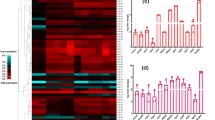Abstract
Recently we demonstrated that lack of mecA transcription was responsible for the decreased methicillin resistance phenotype of strongly slime-negative Staphylococcus epidermidis phase variants [Mempel M, Feucht H, Ziehbuhr W, Endres M, Laufs R, Grüter L (1994) Antimicrob Agents Chemother 38:1251–1255]. In the present study we compared the beta-lactam susceptibility and the slime production capacity of 60 phenotypic variants of S. epidermidis parent strain RP62A identified by their colony morphology on congo red agar. We could show that the variable degree of slime production is linked to different levels of β-lactam susceptibility in intermediate-stage phase variants. The increased deltahemolysin production of slime-negative phase variants may indicate an accessory gene regulator-like control.
Similar content being viewed by others
References
Baddour LM, Barker LP, Christensen GD, Parisi JT, Simpson WA (1990) Phenotypic variation of Staphylococcus epidermidis in infection of transvenous endocardial pacemaker electrodes. J Clin Microbiol 28:676–679
Christensen GD, Simpson WA, Bisno AL, Beachey EH (1983) Experimental foreign body infections in mice challenged with slime-producing Staphylococcus epidermidis. Infect Immun 40:407–410
Christensen GD, Simpson WA, Younger JJ, Baddour LA, Barret FF, Melton DM, Beachey EH (1985) Adherence of coagulase-negative staphylococci to plastic tissue culture plates: a quantitative model for the adherence of of staphylococci to medial devices. J Clin Microbiol 22:996–1006
Christensen GD, Baddour LM, Simpson WA (1987) Phenotypic variation of Staphylococcus epidermidis slime production in vitro and in vivo. Infect Immun 55:2870–2877
Christensen GD, Baddour LM, Madison BM, Parisi JT, Abraham SN, Hasty DL, Lowrance JH, Josephs JA, Simpson WA (1990) Colonial morphology of staphylococci on Memphis agar: phase variation of slime production, resistance to β-lactam antibiotics, and virulence. J Infect Dis 161:1153–1169
Davenport DS, Massanari RM, Pfaller MA, Bale MJ, Streed SA, Hierholzer WJ Jr (1986) Usefullness of a test of slime production as a marker for clinically significant infections with coagulase-negative staphylococci. J Infect Dis 153:332–339
Deighton M, Pearson S, Capstick J, Spelman D, Borland R (1992) Phenotypic variation of Staphylococcus epidermidis isolated from a patient with native valve endocarditis. J Clin Microbiol 30:2385–2390
Deighton MA, Castick J, Borland R (1992) A study of phenotypic variation of Staphylococcus epidermidis using Congo red agar. Epidemiol Infect 109:423–432
Diaz-Mitoma F, Harding GKM, Hoban DJ, Roberts RS, Low DE (1987) Clinical significance of a test for slime production in ventriculoperitoneal shunt infections caused by coagulase-negative staphylococci. J Infect Dis 156:555–560
Freeman DJ, Falkner ER, Keane CT (1989) Neur method for detecting slime production by coagulase-negative staphylococci. J Clin Pathol 42:872–874
Gemmell CG (1983) Extracellular toxins and enzymes of coagulase negative staphylococci. In: Easmus CSF, Adlam C (eds) Staphylococci and staphylococci infections, vol 2. Academic Press, London, pp 809–827
Grüter L, Laufs R (1991) Protoplast transformation of Staphylococcus epidermidis. J Microbiol Methods 13:299–304
Grüter L, Feucht H, Mempel M, Laufs R (1993) Construction of a slime negative transposon mutant in Staphylococcus epidermidis using the Enterococcus faecalis transposon Tn917. Microbiol Immunol 37:35–40
Ishak MA, Gröschel DHM, Mandell GL, Wenzel RP (1985) Association of slime with pathogenicity of coagulase-negative staphylococci causing nosocomial septicemia. J Clin Microbiol 22:1025–1029
Koitilainen P (1990) Association of coagulase-negative staphylococcal slime production and adherence with the development and outcome of adult septicemias. J Clin Microbiol 28:2779–2785
Kornblum J, Kreiswirth JBN, Projan SJ, Ross H, Novick RP (1990) agr: a polycistronic locus regulating exoprotein synthesis in S. aureus. In: Novick RP (ed) Molecular biology of the staphylococci. VCH, New York, pp 373–402
Mack D, Siemssen N, Laufs R (1992) Parallel induction by glucose of adherence and a polysaccharide antigen specific for plastic-adherent Staphylococcus epidermidis: evidence for functional relation to intercellular adhesion. Infect Immun 60:2048–2057
McKewitt IA, Bjornson GL, Mauracher CA, Scheifele DW (1990) Amino acid sequence of a delta-like toxin from S. epidermidis. Infect Immun 58:1473–1475
Mempel M, Feucht H, Ziehbuhr W, Endres M, Laufs R, Grüter L ( 1994) Lack of mecA trancription in slime-negative phase variants of methicillin-resistant Staphylococcus epidermidis. Antimicrob Agents Chemother 38:1251–1255
Morfeldt E, Janzon L, Arvidson S, Lofdahl S (1988) Cloning of a chromosomal locus (exp) which regulates the expression of several exoprotein genes in Staphylococcus aureus. Mol Gen Genet 211:435–440
Peng HL, Novick RP, Kreiswirth B, Kornblum J, Schlievert P (1988) Cloning, characterization, and sequencing of an accessory gene regulator (agr) in Staphylococcus aureus. J Bacteriol 170:4365–4372
Predari SC, Ligozzi M, Fontana R (1991) Genotypic identification of methicillin-resistant coagulase-negative staphylococci by polymerase chain reaction. Antimicrobiol Agents Chemother 35:2568–2573
Ryffel C, Kayser FH, Berger-Bächi B (1992) Correlation between regulation of mecA transcription and expression of methicillin resistance in staphylococci. Antimicrobiol Agents Chemother 36:25–31
Scheifele DW, Bjornson GL, Dyer RA, Dimmick JE (1987) Delta-like toxin produced by coagulase-negative staphylococci is associated with neonatal necrotizing enterocolitis. Infect Immun 55:2268–2273
Smelzer MS, Hart ME, Iandolo JJ (1993) Phenotypic characterization of xpr, a global regulator of extracellular virulence factors in Staphylococcus aureus. Infect Immun 61:919–925
Younger JJ, Christensen GD, Bartley DL, Simmons JCH, Barrett FF (1987) Coagulase-negative staphylococci isolated from cerebrospinal fluid shunts: importance of slime production, species identification, and shunt removal to clinical outcome. J Infect Dis 156:548–554
Author information
Authors and Affiliations
Rights and permissions
About this article
Cite this article
Mempel, M., Müller, E., Hoffmann, R. et al. Variable degree of slime production is linked to different levels of beta-lactam susceptibility in Staphylococcus epidermidis phase variants. Med Microbiol Immunol 184, 109–113 (1995). https://doi.org/10.1007/BF00224346
Received:
Issue Date:
DOI: https://doi.org/10.1007/BF00224346




